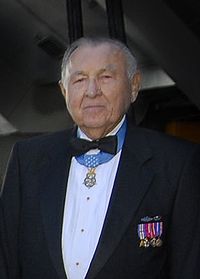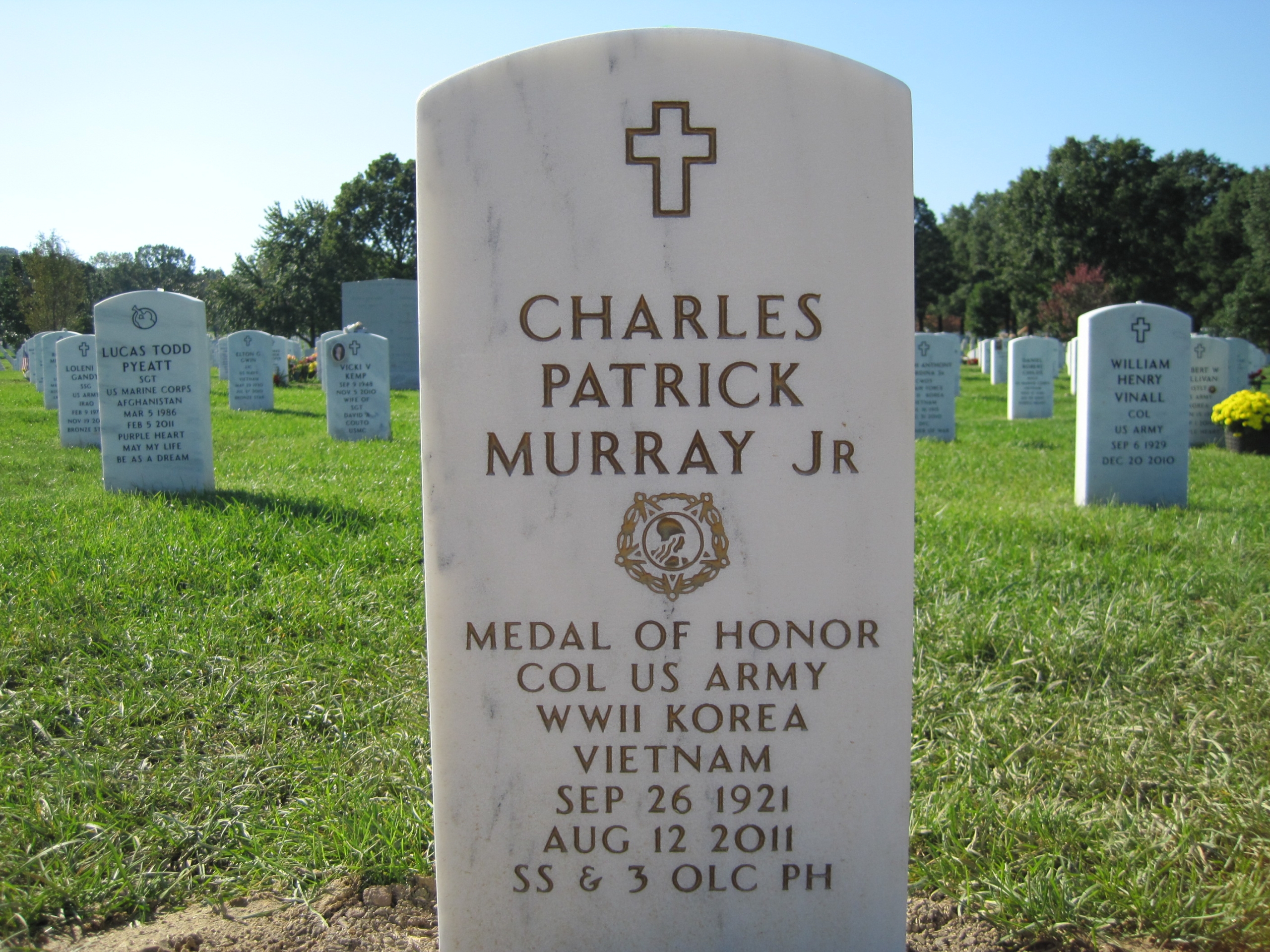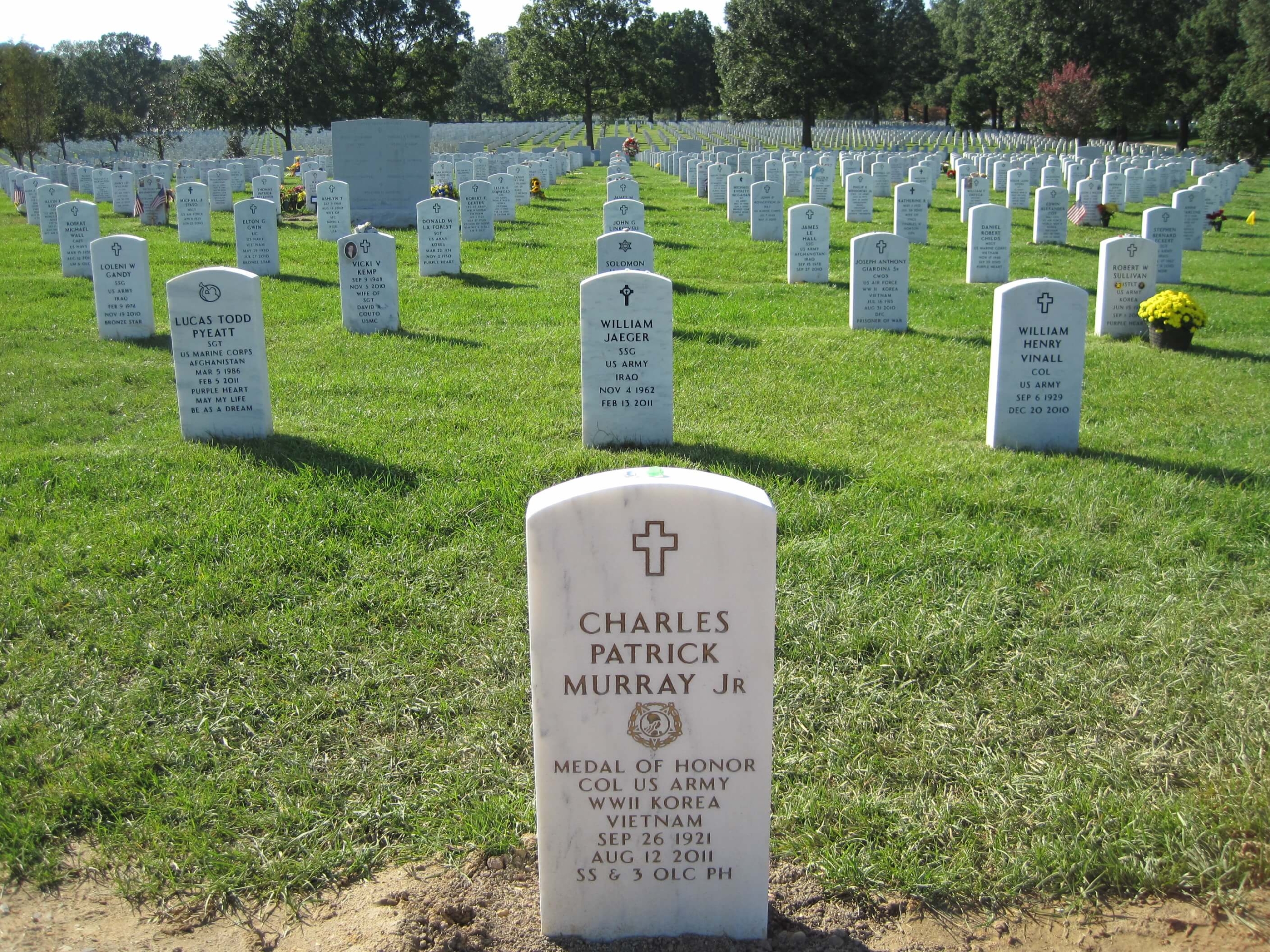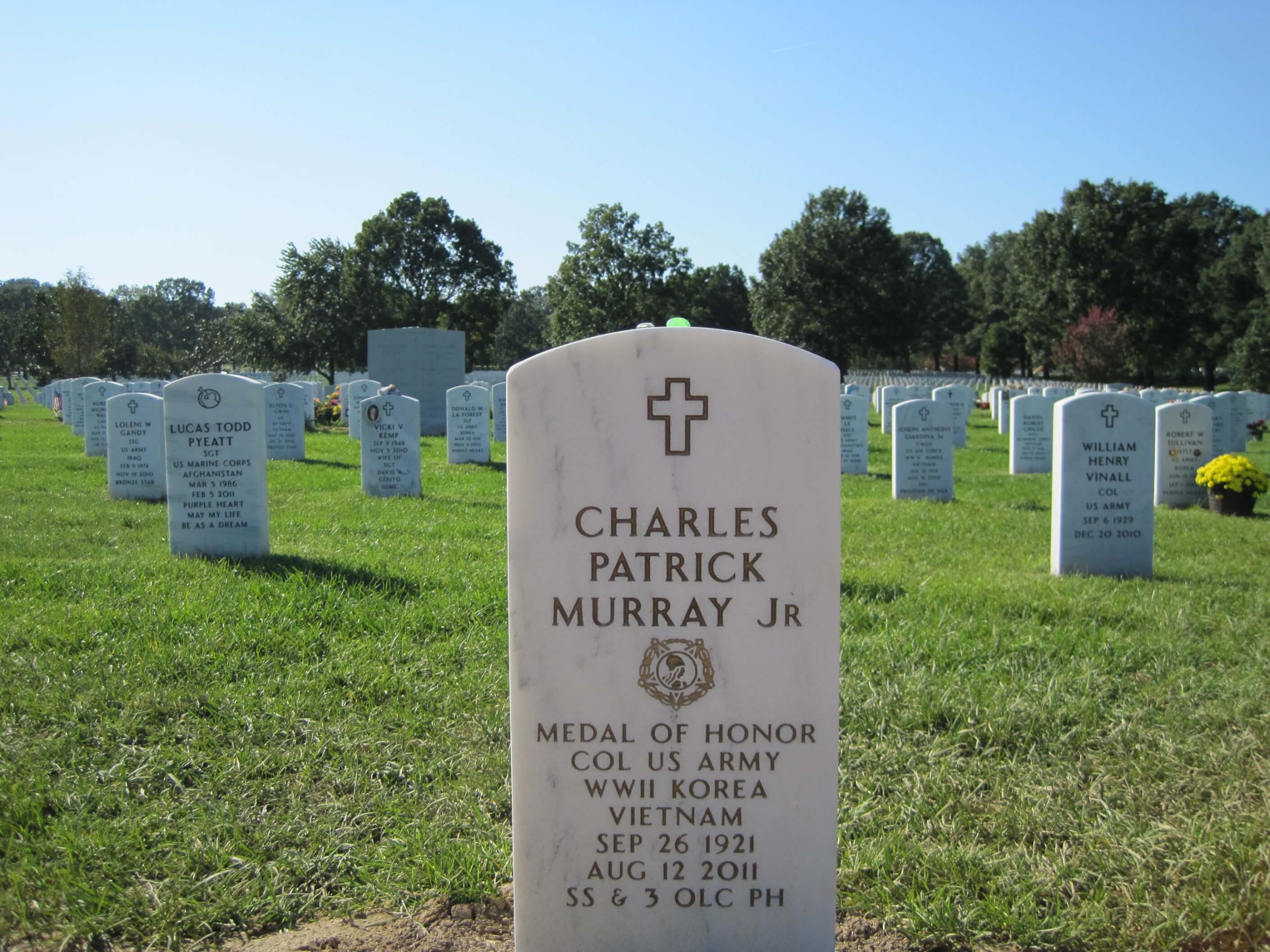
Retired Col. Charles P. Murray Jr., Medal of Honor recipient, dies at 89
Courtesy of The Washington Post
Retired Army Colonel Charles P. Murray Jr., 89, who received the Medal of Honor for single-handedly overcoming a force of 200 German soldiers during a World War II battle in France, died August 12, 2011 at his home in Columbia, South Carolina He had congestive heart failure.
Colonel Murray was a 23-year-old Lieutenant with just a few months of battle experience on December 16, 1944, the day he displayed the “supreme courage and heroic initiative” that earned him the nation’s highest award for military valor.
He had joined the 3rd Infantry Division in France in 1944 after the Normandy invasion that June. Over the course of several brutal days in December, casualties thinned the ranks above him. He became the company commander.
On December 16, he was leading a platoon of about 35 down a mountain path near the town of Kaysersberg, in northeastern France, when he eyed about 200 Germans attacking another battalion of U.S. troops. Rather than take his men into a position where they would be devastatingly outnumbered, he moved forward alone and radioed for an artillery attack. It missed, and before he could correct the coordinates, he lost the radio signal.
He then began launching grenades, revealing his own position and opening himself to a counterattack. Under heavy fire, he exhausted all the available grenades, according to a 2009 Army news release. He returned to his patrol, grabbed a rifle and returned to his position. He fired with such intensity — taking down 20 enemy soldiers and wounding numerous others — that the Germans began to withdraw, according to the Medal of Honor citation.
When reinforcements came, he directed the firing of a mortar and then began running down the hill with his men. He captured 10 Germans hiding in foxholes and was about to capture an eleventh when the man, pretending to surrender, launched a grenade that severely injured Colonel Murphy’s leg and knocked him to the ground.
He refused to leave the battle until he could see that his men were in place and ready to continue on without him.
“By his single-handed attack on an overwhelming force and by his intrepid and heroic fighting,” reads the citation for his Medal of Honor, “First Lieutenant Murray stopped a counterattack, established an advance position against formidable odds, and provided an inspiring example for the men of his command.”
Besides the Medal of Honor, his decorations included three awards of the Silver Star and two awards of the Bronze Star Medal.
Charles Patrick Murray was born in Baltimore on September 26, 1921, the oldest of three boys. He was raised in Wilmington, North Caroloina, where his father found work as a barber.
He was attending the University of North Carolina at Chapel Hill when he enlisted in the Army and returned to college after the war to graduate in 1946 with a degree in accounting. In 1963, Col. Murray received a master’s degree in international affairs from George Washington University.
Colonel Murray learned that he would receive the Medal of Honor not from the Army, but from his wife, the former Anne King, to whom he was married for 68 years. She mailed him a newspaper clipping from home announcing the news.
Besides his wife, survivors include two children, Brian Murray of Fort Payne, Alabama, and Cynthia Anne Murray of Roswell, Geogia; four grandchildren; nine great-grandchildren; and one great-great-granddaughter. His son Charles P. Murray III died in 2004. Both sons served in Vietnam.
After World War II, Colonel Murray reenlisted and became a member of the 82nd Airborne Division. He was a veteran of the Korean and Vietnam wars. After his retirement from the military in 1973, he worked for the South Carolina Department of Corrections.
In an interview last year with a South Carolina newspaper, Col. Murray downplayed his bravery at age 23. “I was old, compared to a lot of those 18- and 19-year-old kids in the division,” he said.
Charles Patrick Murray, Jr., (September 26, 1921–August 12, 2011) was a United States Army officer and a recipient of the United States military’s highest decoration—the Medal of Honor—for his actions in World War II.
Born on September 26, 1921, in Baltimore, Maryland, Murray moved to Wilmington, North Carolina, at age one. Although he was not an actual Eagle Scout he received the honorary Distinguished Eagle Scout Award in 1971. There are only seven known Eagle Scouts who also received the Medal of Honor. After graduating from Wilmington’s New Hanover High School in 1938, he attended the University of North Carolina. He was drafted into the U.S. Army in 1942, after his third year of college.
Arriving in northeastern France in October 1944, Murray was assigned as a replacement platoon leader to Company C of the 30th Infantry Regiment, 3rd Infantry Division. The division had landed in Saint-Tropez on the southern coast of France months earlier and was pushing northward towards Germany. On December 8 of that year, Murray became Company Commander.
Early on December 16, Company C crossed the Weiss River in the northern Vosges Mountains and established a defensive position atop Hill 512, just south of the village of Kaysersberg. Later that morning, Murray, by then a First Lieutenant, led a platoon-sized group on a reconnaissance mission to the southeast, towards Ammerschwihr. Descending the vineyard-covered hill along a winding footpath, the group noticed German soldiers in a sunken road, about 150 yards (140 m) away, firing on an American hilltop position. Creeping forward to a point from which he could see the German unit, about 200 men strong, Murray made a radio call for artillery support. When the artillery landed slightly off target, he attempted to call for a range correction but the radio went dead. Not wanting to send his patrol against the much larger German force, he retrieved rifle grenades from his men and returned to his vantage point to begin a single-handed attack on the position. Although his fire alerted the Germans to his location, he continued to shoot grenades and later an automatic rifle into the German unit. As the soldiers attempted to withdraw, he disabled a truck which was carrying out three mortars. Members of his patrol brought up their own mortar, and Murray directed its fire until the Germans had scattered towards Ammerschwihr.
Continuing on the footpath, he and his men captured ten German soldiers. An eleventh soldier approached him with his helmet off and his arms raised. When Murray turned to shout orders, the soldier tossed a grenade; the explosion knocked Murray to the ground and sent eight pieces of shrapnel into his left leg. After getting back to his feet, he stopped his men from killing the prisoner. Only after organizing the patrol into a defensive position did he turn over command of the company and find an aid station.
After receiving medical treatment, Murray rejoined his unit on December 28, 1944. He learned that he had been recommended for the Medal of Honor in March of the next year and, per Army policy, was soon removed from combat. He remained with his division and was in Salzburg, Austria, on May 7, 1945, when a ceasefire was declared. The next day, Germany’s surrender was finalized and the war in Europe was over.
Murray was issued the Medal of Honor on August 1, 1945, eight months after the fight near Kaysersberg. It was formally presented to him during a ceremony in Salzburg, with the entire 3rd Infantry Division in attendance. He arrived home in Wilmington in September to a hero’s welcome, but later returned to Europe and served four years of occupation duty. During this time, he was stationed in Salzburg and became the head U.S. intelligence officer in that city.
In addition to the Medal of Honor, Murray received three Silver Stars, two Bronze Stars with Valor devices, a Purple Heart, and the Combat Infantryman Badge for his World War II service.
Murray remained in the Army after World War II, serving with the 82nd Airborne Division and participating in the Korean and Vietnam Wars. He eventually rose to the rank of Colonel and commanded the 3rd US Infantry Regiment (The Old Guard), a ceremonial unit tasked with guarding the Tomb of the Unknowns, among other duties. In 1970, he transferred to Fort Jackson in Columbia, South Carolina, from where he retired in 1973.
As a civilian, Murray worked for the South Carolina Department of Corrections until his final retirement. He and his wife, Anne, lived in Columbia, South Carolina until his death from congestive heart failure on August 12, 2011. Murray Middle School in Wilmington is named in his honor.
Murray’s official Medal of Honor citation reads:
For commanding Company C, 30th Infantry, displaying supreme courage and heroic initiative near Kaysersberg, France, on 16 December 1944, while leading a reinforced platoon into enemy territory.
Descending into a valley beneath hilltop positions held by our troops, he observed a force of 200 Germans pouring deadly mortar, bazooka, machinegun, and small arms fire into an American battalion occupying the crest of the ridge. The enemy’s position in a sunken road, though hidden from the ridge, was open to a flank attack by First Lieutenant Murray’s patrol but he hesitated to commit so small a force to battle with the superior and strongly disposed enemy.
Crawling out ahead of his troops to a vantage point, he called by radio for artillery fire. His shells bracketed the German force, but when he was about to correct the range his radio went dead. He returned to his patrol, secured grenades and a rifle to launch them and went back to his self-appointed outpost. His first shots disclosed his position; the enemy directed heavy fire against him as he methodically fired his missiles into the narrow defile. Again he returned to his patrol.
With an automatic rifle and ammunition, he once more moved to his exposed position. Burst after burst he fired into the enemy, killing 20, wounding many others, and completely disorganizing its ranks, which began to withdraw. He prevented the removal of 3 German mortars by knocking out a truck. By that time a mortar had been brought to his support. First Lieutenant Murray directed fire of this weapon, causing further casualties and confusion in the German ranks.
Calling on his patrol to follow, he then moved out toward his original objective, possession of a bridge and construction of a roadblock. He captured 10 Germans in foxholes. An eleventh, while pretending to surrender, threw a grenade which knocked him to the ground, inflicting 8 wounds. Though suffering and bleeding profusely, he refused to return to the rear until he had chosen the spot for the block and had seen his men correctly deployed.
By his single-handed attack on an overwhelming force and by his intrepid and heroic fighting, First Lieutenant Murray stopped a counterattack, established an advance position against formidable odds, and provided an inspiring example for the men of his command.
MURRAY, CHARLES PATRICK JR
COL US ARMY
WORLD WAR II, KOREA, VIETNAM
DATE OF BIRTH: 09/26/1921
DATE OF DEATH: 08/12/2011
BURIED AT: SECTION 60 SITE 9725
ARLINGTON NATIONAL CEMETERY
Michael Robert Patterson was born in Arlington and is the son of a former officer of the US Army. So it was no wonder that sooner or later his interests drew him to American history and especially to American military history. Many of his articles can be found on renowned portals like the New York Times, Washingtonpost or Wikipedia.
Reviewed by: Michael Howard




